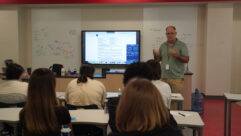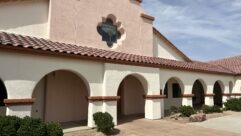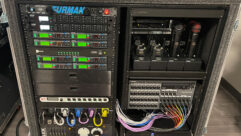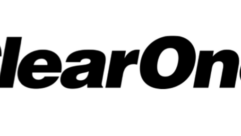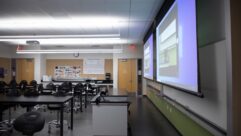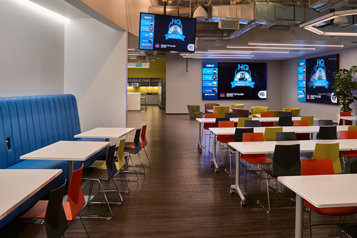

Rocket Fuel is one the fastest growing firms that creates software to manage programmatic online ad campaigns. To thrive in this ultra-competitive business, the company relies heavily on close communication with clients and collaboration between internal teams. When they moved into a new headquarters last year, the company included a best-of-class conference center with more than 50 meeting rooms, each of them based on Crestron technology.
Founded just seven years ago, Rocket Fuel has grown remarkably fast, to more than 1,000 employees and more than 20 branch offices around the world. Its new Redwood City, Calif., headquarters is 10 times larger than the old space. In designing it, those at the company asked Sunnyvale-based integrator Thresher Communications and Productivity to develop technology standards that they would use throughout all of their facilities.
“Our culture is extremely collaborative,” explains Kirk Thompson, director of real estate and facilities.” At the same time, we have to let prospective employees know that we are a great place to work.”
One of the most interesting rooms is an “all-hands” space where CEO George John and the executive team can host monthly town hall meetings. In these open forums, employees can discuss what’s going on with the business and share personal news and achievements. During these meetings, the firm displays a mosaic of live images from each of their main offices. “We call this our Brady Bunch, with one office in each square,” says Tim Keogh, facilities manager.
“Our thought was to create a system that would enable us to easily switch between local and distant offices, with audio and video that’s crisp and clean,” Thompson adds. “And even though our CEO has a Ph.D., we wanted something that you wouldn’t need a Ph.D. to operate.”
To make that possible, the Thresher team standardized on Crestron DigitalMedia to carry video and audio signals within each office, Polycom end points together with the BlueJeans Network service to handle office-to-office communications, and Crestron control to simplify operations. They built a control room behind one of the videowalls, so a technician could make all of the connections and handle cameras and other sources for the town halls. The presenters control smaller meetings.
For the all-hands space, the Thresher team designed a presentation system using two 7ft. high by 12ft. wide videowalls, each with nine 55in. Planar displays in a 3×3 matrix. “We set them up in an L-shaped configuration in the corner of the room, with space for a podium between them,” explains Ishak Kang, program manager at Thresher. That way, facilities staff can set up chairs in a semi-circular arrangement, keeping the entire group relatively close to the podium.
They also ceiling-mounted a projector and six displays farther back in the room to make sure everyone can see clearly.
Since the headquarters is open to employees and their families 24/7/365, the space is also set up as a café, where employees can eat breakfast, lunch, or dinner, meet informally, or watch a movie or a ball game. The videowall most often displays sports from DIRECTV or messages from a Brightsign digital signage system, although there’s also a Blu-ray player and access to Netflix and iTunes videos via Apple TV.
“We included a jukebox service called RockBot,” Keogh adds. “Our people can download a RockBot app for their phones, and then pick songs to play over the sound system in the café, our lounge, or game room.”
An extensive conference center
Another highlight of the headquarters is a four-way divisible meeting room that seats up to 200 people. It’s used frequently for department meetings, such as IT, engineering, marketing, or sales. “Thresher did a great job of automating these rooms,” Keogh says. The Crestron system senses the positions of the airwalls, and then automatically combines or separates the sound and video systems as needed. For example, if the two center rooms are used in combination and the two outer rooms separately, the system automatically routes signals to the appropriate projectors and ceiling-mounted loudspeakers.
Keogh adds that, because the room is so wide when it’s fully opened, they wanted four screens side by side, “We realized that we didn’t want everyone having to crane their necks to look at the presenter.” Instead, an image of the presentation is displayed on the two inner screens, and one of the presenter to the two outer screens. This way, those seated in the center can look directly at the person talking, and those at the outer edges can look at an image from a camera mounted in the back of the space.
That presenter camera is one of two used by a Polycom videoconferencing system Thresher integrated in this room, making it ideal for large multi-office conferences.
“What impressed me was that Thresher really listened to how we wanted to use the room, and then figured out a way to make that happen using the Crestron gear.
The conference center also includes 12 dedicated videoconferencing rooms—four on each floor—plus a boardroom with full-blown presentation and videoconferencing systems. Rocket Fuel also has several “rollabout” videoconferencing systems that they can plug into any of the other meeting rooms, and they’re in the process of adding Crestron control systems to each.
Defining a technology standard
Keogh says he believes a Crestron touchscreen is essential to the simplified use of any of the video or presentation systems, and so Crestron systems are now part of the company’s worldwide technology standard.
“We want all of our rooms to work in the same way, so that our people are more productive and so that we don’t have to provide a lot of support.”
“Saying ‘Crestron,’” he adds, “at least for facilities folks, is almost like saying ‘Frigidaire’ for a kitchen – everyone knows exactly what I’m talking about. There’s a basic touch and feel of a Crestron panel that anyone can understand and start using right away.”
The technology standard Thresher created includes, for larger rooms, a Crestron CP3N control system plus a DigitalMedia 8X8 or 32X32 switcher, DM transmitters, receivers and scalers, QSC amplifiers, Symetrix audio processing, NEC projectors or displays, Polycom videoconferencing, and a user interface based on Crestron 10in. to 15in. touchscreens. In many rooms, including the all-hands and combined spaces, Thresher used Crestron Saros pendant loudspeakers.
For smaller rooms, the standard includes a Crestron DMPS-300-C Presentation System, which combines a control system, 7×4 matrix switcher, a video scaler, audio processor, audio amplifier, and mic mixer, together with NEC displays, Polycom videoconferencing, and Crestron 5in. to 10in. touchscreens.
“Once we established this standard for Rocket Fuel,” Kang explains, “we started rolling it out worldwide, doing the headquarters installation ourselves, but helping the company contract for installation in the more distant locations. We do handle all remote site design and manage their Crestron programming globally.”
In the extremely competitive environment the company lives in, the Crestron technology standard helps keep everyone on the same page. “We need to see each other clearly and see each other’s’ expressions when we’re trying to explain something,” Keogh adds.
“That is, if you say you understand something, your expression will tell me if you really did.”
“The technology we use helps keep us very nimble.”


